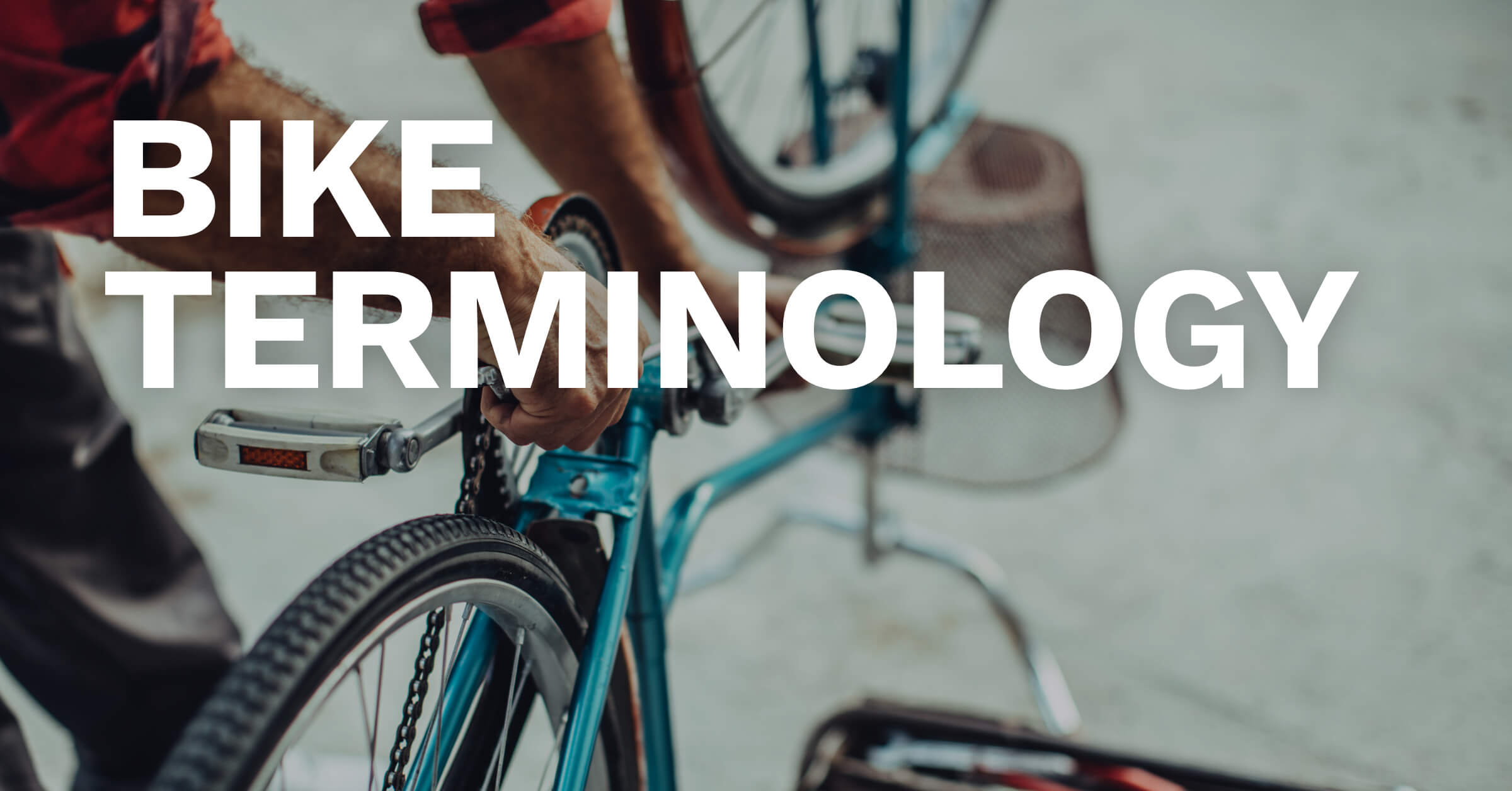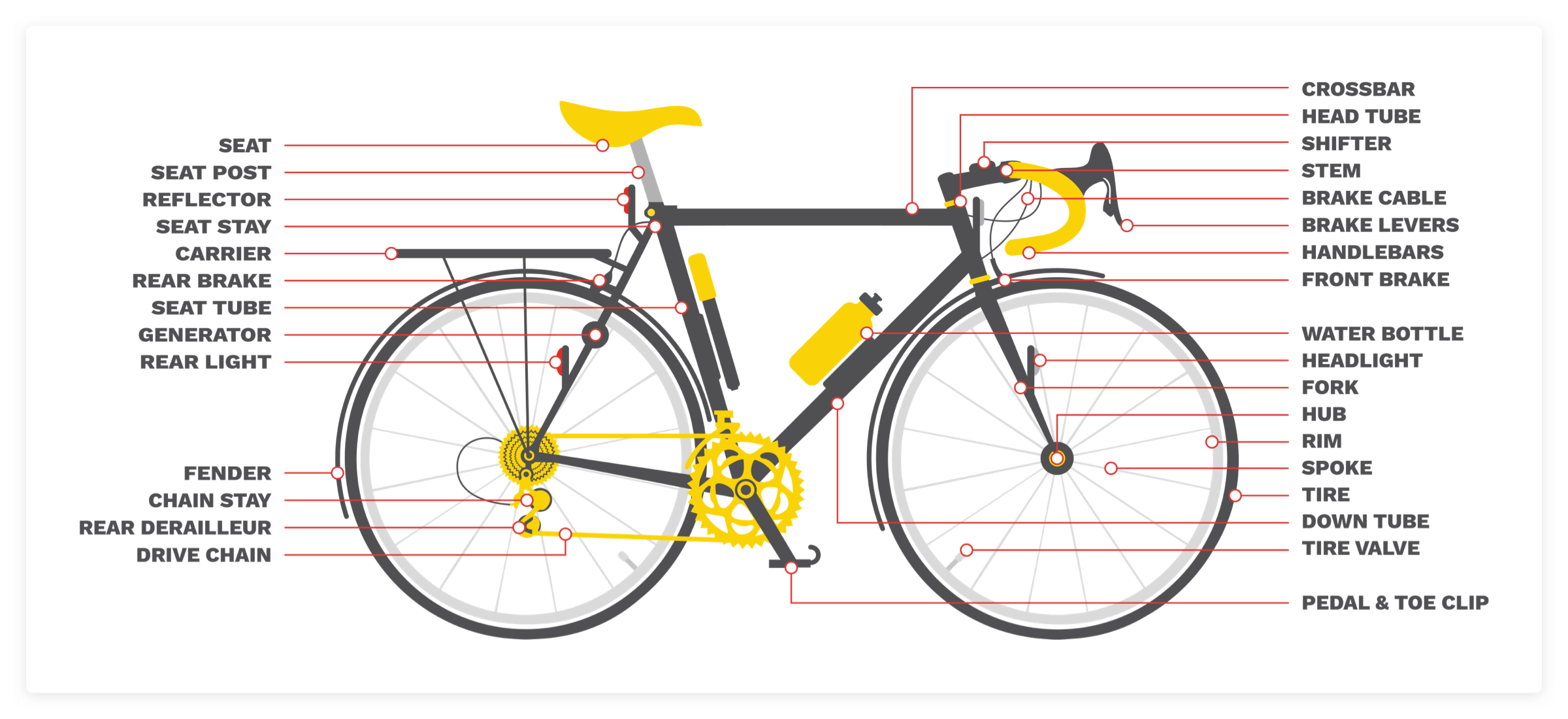
Everything You Need To Know About Bikes and Bike Parts
Owning a bike is a great way to get out and about. Whether you want to cycle for your commute, as a hobby or for your mental health, there is a lot you should know about buying, owning and maintaining a bike first. To help get your bike rides off to a great start, we've detailed everything to know about bikes. In this guide, we'll cover the basics including:
- Essential bike parts
- Optional bike parts
- Choosing the right bike
- How to maintain your bike
- Riding a bike
Essential Bike Parts
Whether you are new to cycling or need to replace some parts, it is important to know your way around the bike so you can get the parts you need. We'll share the bike terminology for essential and optional bike components as well as showing you where everything is on your bike.
Pedal
This is the part of the bike that you put your feet on. It allows you to gather the momentum needed to move the bike forwards by putting pressure on the pedals which get the wheels turning.
Front derailleur
The front derailleur sits parallel to the chainrings and shifts the gears by lifting the chain from one chainring to the other. This allows you to adapt to different road conditions.
Chain (or drive chain)
The chain transfers power from the pedals to the drive wheel which moves the bike forwards.
Chainstay
This is a pair of tubes closest to your bike chain connecting the pedal and crank to the rear fork ends.
Rear derailleur
This shifts the gears at the rear of the bike and lifts the chain from one gear wheel to the other.
Rear brake
Activated by pulling the lever at the handlebars. This causes the brake pads to clamp around the rear tyre, allowing you to slow down.
Seat tube
This is the part of the bike that the seat post fits into. The seat post connects the saddle and the height can be adjusted by lowering the seat post down the seat tube.
Seat stay
The seat stay connects to the top of the seat tube with the rear wheel hub.
Seat post
This is the tube that slots inside the seat tube and extends upwards with the saddle sitting on top.
Seat
Often called the saddle, the bike seat supports your buttocks and back while cycling and is one of five points of contact on the bike.
Crossbar
Commonly found on men's bikes, a horizontal crossbar provides stability and support, connecting the head tube with the seat tube.
Down tube
Connecting the head tube to the bottom bracket shell, the downtube is the longest and thickest tube on the bike and comes under a lot of force.
Tire valve
There are two types of valve a bike may have; either a schrader valve, or a presta valve. Your bike will have one or the other and they allow air into the tyre and prevent it from escaping.
Spoke
Wheel spokes are the rods that span from the centre hub of the wheel to connect at the wheel rim.
Tire
The bike tire fits around the rim of the wheel and encases the inner tube. It is coated in rubber and is the only contact between you and the road.
Rim
This is the outer edge of the wheel where the spokes are connected and the tire slots around the inner tube.
Hub
The spokes come from the hub which is at the centre of the wheel. The hub allows the wheel to rotate around its axle.
Fork
A bike fork has two blades that sit on either side of the front wheel and hold it in place. The fork connects the handlebars to the front wheel which allow you to steer.
Front brake
The front brake is most commonly used to regulate speed when you are cycling as it is generally the more effective brake.
Brake lever
The brake levers are attached to the handlebars and release hydraulic fluid when pulled which activates the brake pads to close around the wheel.
Headtube
This connects the handlebars and fork which enable you to steer the bike.
Stem
The stem connects the handlebars to the frame of your bike and is inserted into the head tube which allows the height of the handlebars to be adjusted.
Handlebars
Handlebars allow you to steer the bike. They are connected to the bike frame by a tube and are just like having a steering wheel.
Brake cable
The brake cable connects the brake lever on the handlebars to the brake pads surrounding the wheels.
Shifter
Shifters are the gear controls that allow you to move up and down the gears via the derailleur.

Optional Bike Parts
Toe Clip
These are like cages that surround the toes and help to keep the feet in a comfortable cycling position and increase cycling power.
Reflector
Designed to keep you safe on the road, these rectangular prisms reflect light so that other road users can
Fender
Not all bikes have fenders but they can help to catch the water spraying up from the tire. Fenders are a curved piece of metal that covers part of the wheel.
Rear light
Rear lights go on the back of your bike and should be switched on when light levels are low so you can be seen by other road users.
Generator
When you pedal, a generator can convert your pedal power into electricity to power the front and rear lights on your bike.
Carrier (aka Rear Rack)
Attached to the back of your bike, a carrier sits above the rear tire and allows you to carry luggage on your bike.
Tire pump
It is always a good idea to carry a tire pump with you when cycling. This allows you to re-inflate your tire if it is low on air.
Water bottle clip
Usually attached to the downtube on your bike, a water bottle clip is a convenient way to carry water with you when you are cycling.
Headlight
Just like a car, the headlights on your bike are at the front and allow you to be seen by other road users.
Once you are familiar with all of the parts on your bike, it makes it much easier to understand how everything works in sequence. It also means that if anything on your bike ever needs replacing, you will know where to look and what to ask for. Being comfortable with your bike and how it works will likely make you feel much more confident about taking them out on the road. So, why not check out our bike racks now and start planning your next cycling adventure.
Choosing the right bike
Choosing a bike is no small task and you need to make sure you are choosing the right bike for the terrain you will be cycling on most. Once you've refined your choice, the next steps are choosing the right size bike and adjusting the seat height. We'll help you choose the right bikes for both yourself and your children below.
How to choose a bike
If you're new to cycling, choosing the right bike can be tricky and there are a few things to consider first. You need to think about what you will be using the bike for, what type of terrain you will be cycling on and if you need the bike to meet any other practical requirements like an e-bike or folding bike. With this in mind, there are a number of bikes you can choose from including:
- Road bike
- Mountain bike
- Hybrid bike
- Touring bike
- All road bike
- Cyclocross
- Single speed bike
- City bike
- Electric bike
- Folding bike
Each bike comes with its own set of benefits so you can decide which would meet your needs best.
Learn more about how to choose a bike here.
What size bike do I need?
Once you've chosen the type of bike you want, you need to determine what size bike you need. To do this you will need to:
- Measure your height
- Choose the type of bike
- Follow the guidelines about what size bike you need for your height and chosen bike type
Once you have worked out your height and selected your bike type, you can use our charts to decide white size bike you need. Alternatively, you can go to your local bike shop to be measured and they can help you find the right size bike too.
Learn how to find the right size bike for both you and your child here.
How to choose an electric bike
Electric bikes are a great choice if you'd like a little extra assistance while cycling. If you have decided an e-bike will be best for you, there are actually a few different types to choose from depending on the terrain and how you would like to store it. The main types of electric bikes include:
- Electric hybrid
- Electric road bike
- Electric mountain bike
- Folding electric bike
Electric bikes are typically much more expensive than your standard push bike so it's important to consider your budget before you get your heart set on an electric bike that might be out of your price range.
Learn more about how to choose an electric bike here.
How high should a bike seat should be?
The main reason for adjusting your bike seat height is so you can maintain a comfortable riding position. This will vary from person to person and may even differ depending on the type of bike you have and your personal preferences. However, there are a few things you can consider when adjusting your bike seat to make sure it's the right height for you. These are:
- Why you should you adjust your seat height
- How you can adjust your seat height
- Working out how high your bike seat should be
- Adjusting the saddle tilt
Learn more about your bike seat height and how to adjust it here.
The best children's bikes
From toddlers to teenagers, the right bike for your child will likely depend a lot on their age. For example, you wouldn't put a toddler straight on a two-wheel push bike if they've never ridden before just like you wouldn't buy a balance bike for a 10-year-old who knows how to ride. So, when choosing a bike for your child, you need to consider:
- The right size bike
- A sturdy bike, rather than a heavy one
- Whether they need gears
- Your budget
Finding the right bike for your child might come down to personal preference too. So, you might find that visiting a local bike shop with your child and trying out a few different bikes is useful before you make a purchase.
Learn more about how to choose a bike for your child here.
Choosing a child's bike seat
If you're going on a longer bike ride with small children then a child's bike seat is essential. Not only is it difficult for small children to keep up, but your little one might not be old or strong enough to ride their own bike yet. Luckily, there are lots of different bike seats to choose from to make the journey safer and more comfortable for everyone. These include:
- Rear child bike seats
- Cantilevered rear child bike seat
- Rack-mounted child bike seat
- Front or centre-mounted bike seats
There are pros and cons to each type of child bike seat and they will all need to be fitted differently too.
Learn more about how to choose a child's bike seat here.
How to maintain your bike
Taking proper care of your bike is essential to making sure it is safe to ride and will last for many years. But to do this, you need to know the basics like how to look after and clean your bike and how to pump and change a tyre. Luckily, we've got a number of handy guides that will help you to maintain your bike correctly.
Top tips to look after your bike
Once you've purchased a new bike, you'll want to take good care of it so you can save on costly repairs and replacement parts. It is also important to know how to do basic repairs which will come in handy if you're out on a bike ride and are far away from home. The basic maintenance check you need to know includes:
- Basic safety checks
- How to fix a puncture
- Cleaning and lubrication
- Understanding your brakes
- Setting up gears
- Bike tool kit
Learn more about how to look after your bike here.
How to clean a bike
If you're out cycling in the mud and rain, it's only natural that you're bike will get dirty from time to time. Unfortunately, it's not quite as easy as running a hose pipe over it and leaving it to dry. You need to use proper cleaning products and methods to avoid rust and abrasion. To successfully clean your bike and avoid any further wear and tear you'll need:
- Two buckets with water
- Bike cleaning product
- Bike degreaser
- Cloths & sponges
- Soft bristle brushes
- Lubricant
Learn how to clean your bike with ease here.
How to pump and change a bike tire
Whether you're at home or halfway through a bike ride, knowing how to pump and change a bike tire is essential. Not only can it save you money by not seeking professional help, but it can also allow you to change the tyre and get back on the road as soon as possible without a lengthy walk home. Before you set off on a bike ride though, you need to make sure you have the right pump for your bike, depending on the valve you have.
Learn how to pump and change a bike tire here.
Riding a bike
It's only as easy as riding a bike if you already know how! So, whether you're learning for the first time as an adult or you're trying to teach the kids, there are a few things worth knowing first before you get on the saddle.
How to ride a bike
The most important thing to understand before you try and ride a bike is how to do it safely to avoid injury. From setting up your bike and getting to know it to pedalling for the first time, we've covered all you need to know to get cycling safely.
If you're teaching a child to ride a bike, there are a few simple steps you can follow to build their confidence and get them cycling in no time. These include:
- Learning how to balance
- Learning how to pedal
- Applying the brakes
- Taking off any training wheels
Learn more about how to ride a bike here.
How to use bike gears
Bikes have gears in the same way that cars do. Only when you're riding a bike, you don't have to change gears, but it's nice to have the option. From shifting into a lower gear when climbing uphill to using a higher gear for the descent, knowing how to use your gears can make your bike ride much easier. To use bike gears effectively, you need to know:
- What bike gears are
- What the numbers mean on bike gears
- Why you need bike gears
- How you'll know when to change gears
- How to use bike gears
Learn more about how to use bike gears here.
What to wear when cycling
You could technically wear anything you want when you go cycling, but there are plenty of things that can make your bike ride safer and more comfortable. If you're commuting to work, it's probably a good idea to wear appropriate cycle clothing and change once you get to work so you feel fresh. Equally, baggy trousers or tight jeans can be uncomfortable when cycling or could catch on the pedals so consider investing in appropriate cycling bottoms, tops and weatherproof clothing.
Learn more about what to wear cycling here.
The best family bike rides
Once you understand how to ride a bike and what to wear, you can start enjoying bike rides. From mountain bike routes to easy cycle trails along canals, there are plenty of places to go cycling in the UK. However, if you're taking little ones along, you might want to keep the route short or make time for lots of breaks along the way.
Learn about the best family bike rides in the UK here.
Buying a bike is a great way to explore the great outdoors with the family. Now you know how to choose, ride and maintain a bike properly, you can start enjoying outdoor adventures more frequently. Whether you'll be using your bike for the morning commute or you plan on going cycling with the family, there are plenty of great bike rides to enjoy around the UK. Take your bike rides even further by adding a bike rack to your vehicle and start planning your next family bike ride now.

